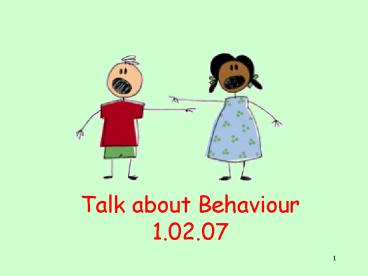Talk about Behaviour 1.02.07 PowerPoint PPT Presentation
1 / 30
Title: Talk about Behaviour 1.02.07
1
Talk about Behaviour1.02.07
2
(No Transcript)
3
How we pre-empt behaviours
- Functional and meaningful lessons
- High and realistic expectations
- Teaching strategies -visual cues, positive
teaching language, - Resources staff, facilities
- Routines and structure
- Rewards linked to timetables
- Sanctions and contingencies
- Special interests/obsessions
- Fun and enjoyment
- Safe calm areas
- Teaching of social skills
- Social stories and scripts
4
Levels of behaviours
5. Danger to self, others or property
4. Physical outburst may involve property - no
harm likely to people
3. Unco-operative and verbally abusive
2. Unco-operative and disruptive
- Unco-operative but not disruptive
5
Arnetts diagram
6
Which Strategy?
Use visual cues
Ignore behaviour ???
Positive handling
Body language
Rewards
Redirect
Be positive
Offer calmer or de-stressor
Do not invade personal space
Remove possible triggers
Simplify or cut out speech
Keep calm
7
A modified representation of Maslows Hierarchy
of Needs
Level 5 Self-actualisation needs Intellectual
and academic skills,growth, inner sense of
achievement, realising ones own potential
Level 4 Self-esteem needs Being recognised and
valued by others, good self-image, self-respect,
personal autonomy
Level 3 Feeling wanted Love, companionship,
being with compatible people
Level 2 Feeling safe Protection from danger and
threats, physical and mental security
Level 1 Feeling physically comfortable Air,
drink, food, sleep, shelter from heat and cold
8
(No Transcript)
9
Social scripts and social stories to teach
acceptable behaviour
- To introduce unfamiliar situations and activities
reduce anxiety - To build self-esteem
- Information on expected behaviour
- To modify behaviour
10
We always aim to link these to the childrens
interests
REWARDS are central to encouraging and managing
positive behaviour
11
(No Transcript)
12
A LAST RESORTpositive physical handling
ensuring dignity, respect and personal safety for
all concerned
13
- 85 of pupils do not need a Positive Handling
Plan - Some pupils need help just to overcome a
difficult period
14
- PAMOVA
- and
- Team Teach
15
Levels of behaviours
5. Danger to self, others or property
4. Physical outburst may involve property - no
harm likely to people
3. Unco-operative and verbally abusive
2. Unco-operative and disruptive
- Unco-operative but not disruptive
16
Unco-operative but not disruptive
- Crying
- Twirling
- Dropping
- Low level self stimulation
17
Unco-operative and disruptive
- Screaming
- Throwing
- Tipping chairs
- Climbing
- dropping
18
Unco-operative and verbally abusive
- Verbal threats Im going to get you
- Physical threats - raised fists
19
Physical outburst may involve property - no
harm likely to people
- Kicking, banging furniture
- Ripping up work
- Tearing work off walls
20
Danger to self, others or property
- Self injurous biting scratching, head banging,
head hitting , slapping own face, throwing body
at different surfaces - Kicking, slapping, scratching etc. towards others
(intentional and unintentional)
21
- Behaviour Function
- e.g slamming doors
22
- Frequency Chart
23
ABC Charts
- A ntecedent
- B ehaviour
- C onsequences
24
Antecedent
- Where
- With whom
- Time day , week , month
- What happens directly before
25
Behaviour
- Frequency
- How long does it last?
- Level of intensity
- If its a tantrum what does it look like?
26
Consequence
- What happens as a result of targeted behaviour?
- Is it being reinforced?
- Is it rewarding to child?
- Who deals with behaviour?
- Does child receive favoured items/activities?
27
Which Strategy?
Use visual cues
Ignore behaviour ???
Positive handling
Body language
Rewards
Redirect
Be positive
Offer calmer or de-stressor
Do not invade personal space
Remove possible triggers
Simplify or cut out speech
Keep calm
28
(No Transcript)
29
Social scripts and social stories to help modify
behaviours
30
- Established and difficult to modify behaviours.

